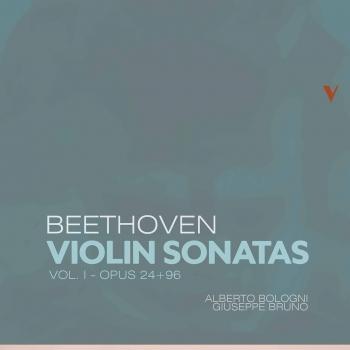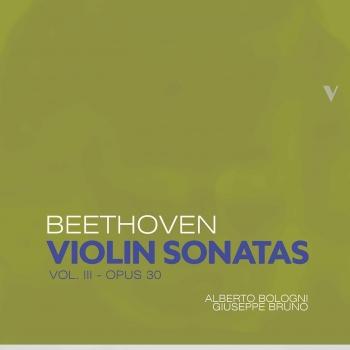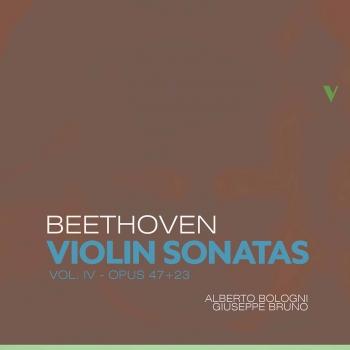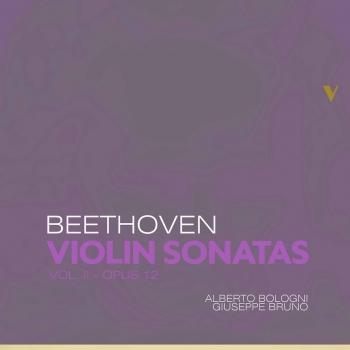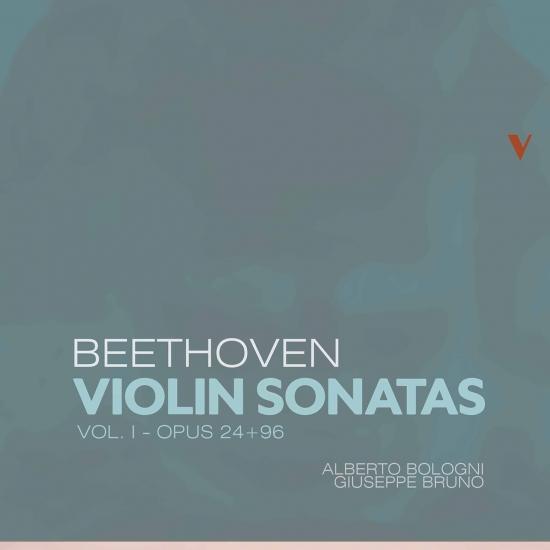
Beethoven: Violin Sonatas, Vol. 1 – Opp. 24 & 96 Alberto Bologni & Giuseppe Bruno
Album info
Album-Release:
2020
HRA-Release:
03.04.2020
Label: OnClassical
Genre: Classical
Subgenre: Chamber Music
Artist: Alberto Bologni & Giuseppe Bruno
Composer: Ludwig van Beethoven (1770–1827)
Album including Album cover
- Ludwig van Beethoven (1770 - 1827): Violin Sonata No. 5 in F Major, Op. 24 "Spring":
- 1Violin Sonata No. 5 in F Major, Op. 24 "Spring": I. Allegro10:21
- 2Violin Sonata No. 5 in F Major, Op. 24 "Spring": II. Adagio molto espressivo05:36
- 3Violin Sonata No. 5 in F Major, Op. 24 "Spring": III. Scherzo. Allegro molto01:18
- 4Violin Sonata No. 5 in F Major, Op. 24 "Spring": IV. Rondo. Allegro ma non troppo07:07
- Violin Sonata No. 10 in G Major, Op. 96 "Cock-Crow":
- 5Violin Sonata No. 10 in G Major, Op. 96 "Cock-Crow": I. Allegro moderato10:46
- 6Violin Sonata No. 10 in G Major, Op. 96 "Cock-Crow": II. Adagio espressivo06:10
- 7Violin Sonata No. 10 in G Major, Op. 96 "Cock-Crow": III. Scherzo. Allegro02:07
- 8Violin Sonata No. 10 in G Major, Op. 96 "Cock-Crow": IV. Poco allegretto09:14
Info for Beethoven: Violin Sonatas, Vol. 1 – Opp. 24 & 96
The distinguished Italian violin & piano duo are well known on the continent for their powerful interpretations of the classics, and have recently recorded the entire oeuvre for violin and piano by Franz Liszt. They present one such piece in this, their Kings Place debut: the dramatic and striking ‘La notte’, arranged by Liszt from his orchestral piece of the same name (after the poem by Michelangelo).
It is coupled with another work inspired by Italian renaissance literature, the dark and passionate, Dante-inspired ‘…that which echoes in eternity’ by British composer Peter Fribbins. Central pillars of the duo’s programme are Beethoven’s epic G major sonata and Brahms’s lyrical last sonata. They also bring some music from Italy, a charming Aria by Ottorino Respighi.
The success of the Three Sonatas, Op. 12 convinced Beethoven that the genre was worth exploring further: within three years, he completed two other sonatas for piano and violin – Opp. 23 and 24. Originally intended to be published under the same opus number (23), a printing mishap forced the publisher to separate the two works. Nicknamed posthumously as “Fruhlingssonate” (Spring Sonata), the work is the first in the genre to be in four movements. It was dedicated to Count Moritz von Fries, a patron who was also the dedicatee of other works that Beethoven published around the same time. It is perhaps Beethoven’s most popular violin sonata.
By 1803, four more sonatas for piano and violin appeared in print – Opp. 30 and 47. Beethoven seemed to have found a congenial genre, especially in the highly virtuosic “Kreutzer” Sonata, Op. 47. However, it took him nine years to return to the genre. This time, he did so with a highly unconventional work – the Sonata in G Major, Op. 96. The French violinist Pierre Rode gave its premiere, alongside Archduke Rudolph at the piano. Beethoven wrote the final movement specifically with Rode in mind: the celebrated violinist apparently shunned virtuosic outbursts, which compelled the composer to give up the idea of a lively and technically challenging rondo, penning a set of variations on a jovial theme instead – an unusual choice for a closing movement.
The duo formed by violinist Alberto Bologni and pianist Giuseppe Bruno is one of the most long-standing ensemble on the Italian scene. During thirty-five years of activity together, in which they have performed hundreds of concerts, we are happy to announce two important recordings made for our label, OnClassical: and, yes, the first is dedicated to Ludwig van Beethoven.
This four-volume cycle, containing all Beethoven's ten Violin Sonatas, the duo gives an analytical and refined reading, highlighting the compositional complexity of each work.
The recordings was made by sound engineer Alessandro Simonetto using a historical pair of Bruel & Kjaer microphones matched with Prism Sound press and converters equipment. The outcome is a clean and natural sound.
Alberto Bologni, violin
Giuseppe Bruno, piano
Alberto Bologni
(b. Prato, 9th december 1963), studied under the guidance of Sandro Materassi and graduated with full honour at Conservatorio Luigi Cherubini di Firenze. Later he studied with Stefan Gheorghiu and Ilja Grubert, taking the soloist degree at Rotterdams Conservatorium. He also studied quartet with Piero Farulli at Accademia Chigiana di Siena. He was prize winner at Viotti and Spohr Competitions.
Mr. Bologni began his career in 1979, after being awarded the Leonardo da Vinci prize in Florence. He played in duo with the pianist Giuseppe Bruno or as leader of Sandro Materassi string quartet and piano quintet in the most important concert halls and theatres in Italy, Germany, Switzerland, England and Venezuela (Carlo Felice di Genova, Pergola di Firenze, St. John Smith Square Hall in London, Gasteig and Herkulessaal in München, Manzoni di Milano, Caio Melisso di Spoleto Università di Roma, Bellini di Catania etc. etc.). As a soloist he played with such conductors as Bellugi, Bruggen, Dumbraveanu, Harrap, Maschat, Mihaescu, Pinzauti etc. He has been the leading concertmaster since its foundation of Camerata Strumentale Città di Prato, considered one of the best Italian chamber orchestras now operating.
Alberto Bologni recorded CD's for the labels such as Diapason, Arts, Tactus, Cristophorus and through the Materassi ensemble with Radio Svizzera Italiana and Radio Suisse Romande.
Giuseppe Bruno
graduated with honours in Piano, Composition and Conductorship with Professors Specchi, Zangelmi and Taverna. Maestro Bruno specialized in piano with Paolo Bordoni and in conductorship with Leopold Hager. He has attended a seminar in composition at the IRCAM in Paris. Performing for several years as a pianist in many different chamber ensembles as well as a brilliant soloist. He has played with many important orchestras in Italy, USA, Greece, Romania and Germany in a repertory that goes from Mozart to Dallapiccola. From 1987 to 1992 he participated in the “Due Mondi” festival in Spoleto Italy and in 1988 in the Charleston festival in the USA.
In 1991 Maestro Bruno received an award at the International Piano Contest in Rome and in 1992 he received a second award in a duo with violin player Alberto Bologni at the “Viotti” in Vercelli, Italy. He recorded for Nuova Fonit Cetra, Diapason, SAM, Bongiovanni, Ars publica, Ars Musici, as well as for RAI, Swiss French and Italian radio and for WDR in Koeln. He collaborated with directors including Alkis Baltas, Spiros Argiris, Franz Lamprecht, Corneliu Dumbraveanu, violin player Sashko Gawriloff, singers Gail Gilmore and Victor von Halem, and with the Octet of Berlin Philharmonic. He is currently a member of the “Trio Petrarca”. In the past few years he has been acknowledged as a highly regarded conductor in Italy and abroad. Maestro Bruno is at present the Director of the "Giacomo Puccini" Conservatory, in La Spezia, Italy.
This album contains no booklet.













